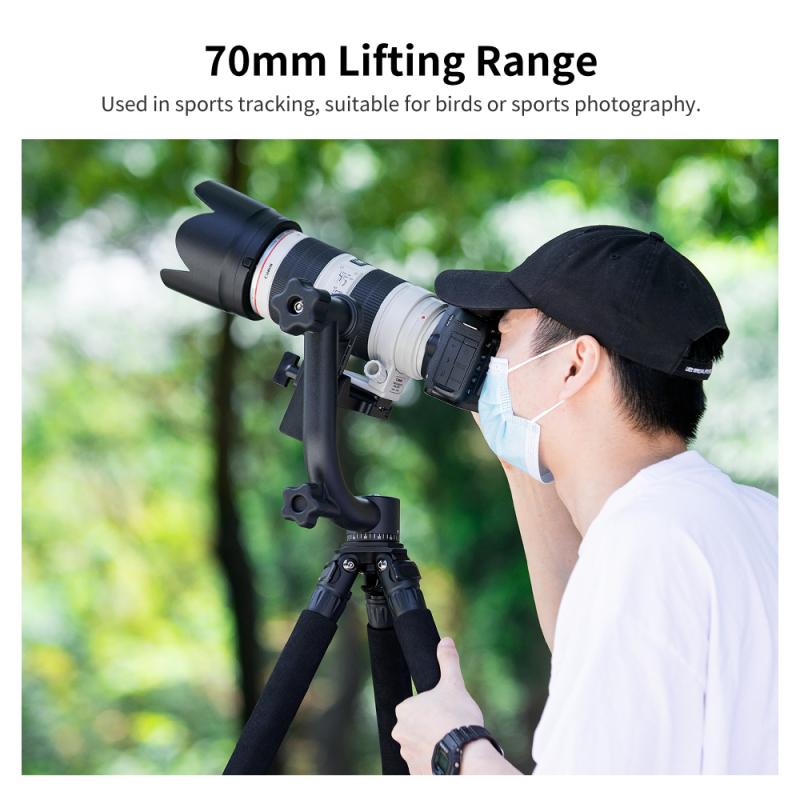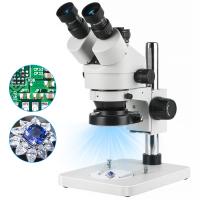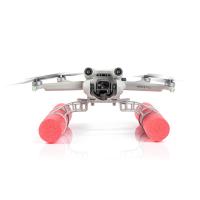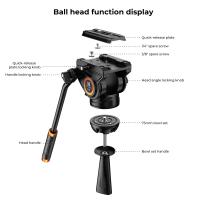How To Make Tripod Stand At Home ?
To make a tripod stand at home, you will need three long and sturdy poles or sticks of equal length. Arrange the poles in a triangular shape, with the tops meeting at a point. Secure the poles together at the top using rope, twine, or zip ties. Make sure the connection is tight and secure. Spread out the other ends of the poles to form a stable base. You can either leave the base as it is or secure it further by tying the poles together at the bottom. Once the tripod stand is assembled, you can use it for various purposes such as holding a camera, supporting a cooking pot over a fire, or as a display stand for plants or artwork.
1、 DIY Tripod Stand: Step-by-step guide for building a homemade tripod.
DIY Tripod Stand: Step-by-step guide for building a homemade tripod.
In today's digital age, having a tripod stand is essential for capturing steady and professional-looking photos and videos. While there are plenty of tripod stands available in the market, building your own can be a fun and cost-effective project. Here is a step-by-step guide on how to make a tripod stand at home.
Materials needed:
1. Three wooden dowels or metal rods (around 3 feet long)
2. A sturdy base (such as a wooden board or metal plate)
3. Screws or bolts
4. A drill
5. A saw (if needed to cut the dowels or rods to size)
6. Sandpaper (to smooth any rough edges)
Step 1: Prepare the base
Start by selecting a sturdy base that will provide stability to your tripod stand. A wooden board or a metal plate works well for this purpose. Make sure the base is large enough to accommodate the three dowels or rods.
Step 2: Attach the dowels or rods to the base
Using a drill, create three holes in the base, evenly spaced apart. The holes should be slightly smaller than the diameter of the dowels or rods. Insert the dowels or rods into the holes and secure them with screws or bolts. Ensure that they are tightly fastened to provide stability.
Step 3: Adjust the height
If you want to adjust the height of your tripod stand, you can add adjustable legs. To do this, attach hinges to the bottom of each dowel or rod and attach adjustable legs to the hinges. This will allow you to extend or retract the legs as needed.
Step 4: Finishing touches
Once the tripod stand is assembled, use sandpaper to smooth any rough edges or surfaces. This will prevent any splinters or scratches while handling the stand.
Building your own tripod stand at home not only saves you money but also gives you the freedom to customize it according to your needs. You can paint or decorate the stand to match your personal style or even add additional features like a smartphone mount or a camera holder.
However, it is important to note that while a homemade tripod stand can be functional, it may not provide the same level of stability and durability as a professionally manufactured one. If you are a professional photographer or videographer, investing in a high-quality tripod stand may be a better option to ensure optimal performance and longevity.
In conclusion, building a DIY tripod stand at home can be a rewarding project for photography enthusiasts. By following these steps and adding your own creative touches, you can have a functional and personalized tripod stand to enhance your photography and videography skills.

2、 Materials Needed: Essential items required to construct a tripod stand.
How to Make a Tripod Stand at Home
If you're looking to create a tripod stand at home, you'll be pleased to know that it can be done with just a few simple materials and tools. A tripod stand is a versatile and useful tool for various activities such as photography, videography, or even as a support for a projector or microphone. Here's a step-by-step guide on how to make a tripod stand at home:
Materials Needed:
1. Three wooden dowels or metal rods: These will serve as the legs of the tripod stand. The length of the dowels or rods will depend on your desired height for the stand.
2. A sturdy base: This can be a wooden board or a metal plate that will provide stability to the tripod stand.
3. Screws or bolts: These will be used to attach the legs to the base.
4. A drill or screwdriver: This will be necessary to create holes for the screws or bolts.
5. Optional: A tripod head or mount: This can be added to the top of the tripod stand to hold your camera or other equipment securely.
Step 1: Measure and cut the dowels or rods to your desired height. Ensure that all three legs are of equal length.
Step 2: Mark the positions on the base where the legs will be attached. Space them evenly around the circumference of the base.
Step 3: Drill holes into the base at the marked positions. Make sure the holes are slightly smaller than the screws or bolts you will be using.
Step 4: Attach the legs to the base by inserting the screws or bolts through the holes and securing them tightly.
Step 5: Optional - Attach a tripod head or mount to the top of the tripod stand. This will provide a secure platform for your camera or equipment.
Step 6: Test the stability of the tripod stand by placing it on a flat surface and adjusting the legs as needed.
Creating a tripod stand at home can be a cost-effective and rewarding project. However, it's important to note that the stability and durability of the stand will depend on the materials used and the construction techniques employed. If you plan to use the tripod stand for heavy equipment or in challenging environments, it may be worth considering purchasing a professional-grade tripod stand for added stability and peace of mind.

3、 Assembly Instructions: Detailed instructions on how to put together the tripod.
Assembly Instructions: Detailed instructions on how to put together the tripod.
Building a tripod stand at home can be a simple and cost-effective solution for various purposes, such as photography, videography, or even as a stable base for a projector. Here is a step-by-step guide on how to assemble a tripod stand at home:
1. Gather the materials: You will need three sturdy and equal-length poles, preferably made of metal or wood, a drill, screws, a screwdriver, and a measuring tape.
2. Measure and mark: Determine the desired height of your tripod stand and mark the length on each pole. Ensure that the marks are at the same height on all three poles.
3. Drill holes: Using a drill, create holes at the marked points on each pole. The holes should be large enough to fit the screws.
4. Connect the poles: Align the holes on the poles and insert screws through them. Tighten the screws using a screwdriver to secure the connection. Ensure that the poles are tightly fastened to provide stability.
5. Adjust the legs: Spread the legs of the tripod stand to form a stable base. You can adjust the angle of the legs to suit your needs, whether you prefer a wider or narrower stance.
6. Test stability: Once the tripod stand is assembled, test its stability by applying gentle pressure on different sides. If it wobbles or feels unstable, check the connections and tighten any loose screws.
7. Optional additions: Depending on your requirements, you can attach a camera mount or a platform to the top of the tripod stand. This will allow you to securely place your camera or other equipment on the stand.
Remember, while building a tripod stand at home can be a fun and practical project, it is essential to prioritize safety. Ensure that the materials used are sturdy and that the connections are secure. Always follow proper safety guidelines when using the tripod stand to avoid accidents or damage to your equipment.
Please note that this answer provides a general guide on how to assemble a tripod stand at home. The specific steps and materials may vary depending on the design and materials available to you.

4、 Stability and Adjustability: Tips for ensuring stability and adjusting the tripod.
Stability and Adjustability: Tips for ensuring stability and adjusting the tripod.
A tripod stand is an essential tool for photographers, videographers, and anyone who wants to capture steady and professional-looking shots. While there are many tripod stands available in the market, you can also make one at home with a few simple materials. Here's a step-by-step guide on how to make a tripod stand at home:
1. Gather the materials: You will need three sturdy wooden or metal rods of equal length, a drill, screws, a saw, and a tripod head (which can be purchased separately).
2. Cut the rods: Use a saw to cut the rods to your desired length. The length will depend on your preference and the height you want the tripod to be.
3. Drill holes: On one end of each rod, drill a hole large enough to fit the screws. These holes will be used to attach the tripod head.
4. Attach the tripod head: Place the tripod head on top of the rods and align the holes. Insert screws through the holes and tighten them to secure the head in place.
5. Adjust the legs: To ensure stability, make sure the legs are spread out evenly and at an angle that provides balance. You can adjust the angle by loosening or tightening the screws on the tripod head.
6. Test for stability: Once the tripod stand is assembled, test its stability by placing it on a flat surface and applying gentle pressure. If it wobbles or feels unstable, adjust the legs until it feels secure.
Now that you have your homemade tripod stand, it's important to ensure stability and adjustability while using it. Here are some tips to keep in mind:
1. Choose a stable surface: When setting up your tripod, make sure to place it on a stable surface. Avoid uneven or slippery surfaces that could cause the tripod to tip over.
2. Extend the legs fully: To maximize stability, extend the legs of the tripod fully. This will provide a wider base and reduce the risk of it toppling over.
3. Use a counterweight: If you're using a heavy camera or lens, consider using a counterweight to balance the weight distribution. This will help prevent the tripod from tipping forward.
4. Avoid windy conditions: Wind can cause vibrations and instability in your tripod. If you're shooting outdoors on a windy day, consider using a sandbag or hanging a weight from the center column to add extra stability.
5. Lock all adjustments: Once you have positioned your camera, make sure to lock all adjustments, including the tripod head and leg locks. This will prevent any accidental movement and ensure a steady shot.
In conclusion, making a tripod stand at home is a cost-effective option for those who want to capture stable shots. By following the steps outlined above and keeping in mind the tips for stability and adjustability, you can achieve professional-looking results without breaking the bank.
































There are no comments for this blog.